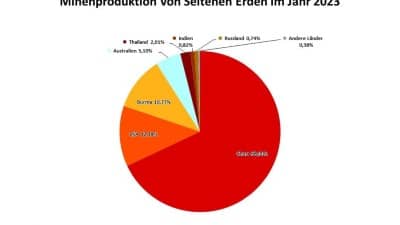Rare earths are mainly used in permanent magnets. Their extraction is complex and costly. Mining mainly takes place in China.
US Geological Survey. (31. Januar, 2024). Anteil der wichtigsten Erzeugerländer an der weltweiten Minenproduktion von Seltenen Erden im Jahr 2023 [Graph]. In Statista. Zugriff am 03. September 2024, von https://de.statista.com/statistik/daten/studie/281730/umfrage/anteil-fuehrender-erzeugerlaender-an-der-weltproduktion-seltener-erden/
Statista
The majority of rare earths are extracted in Chinese mines, as Statista has determined. The statistics provider has determined the shares of the most important producing countries in the global mine production of rare earths in 2023 based on data from the US Geological Survey. According to the study, China accounts for around 68 % of global rare earth production. The USA has a share of around 12 % and Burma around 11 %.
“China is the undisputed world market leader in the mining and processing of critical raw materials […]”, says Springer author Stefan Fröhlich in the German book chapter The Geo-Economic Maps of the Future. This also includes rare earths such as neodymium, dysprosium, europium and cerium. Their regional availability is very limited, and mining them is complex and costly.
Rare earths: Economically Strategic Raw Materials
Traditionally, a distinction is made between light and heavy rare earth elements. “Of the 17 rare earths, four are light rare earths, which make up 95 % of the deposits. These include neodymium, which is required for important technologies such as nuclear magnetic resonance tomographs, computer hard disks, linear motors, loudspeakers and headphones. The 13 heavy rare earths make up only 5 % of the deposits. These include dysprosium, which is used in permanent magnets, among other things, which are installed in large quantities in wind turbines, but also in electric motors, including the many small motors for window regulators etc. in cars”, says Springer author Ronald Bogaschewsky in the German book chapter Resource Scarcity and the Circular Economy.
Not least because of their unique electronic, magnetic, optical and catalytic properties, there are currently no satisfactory substitutes for rare earth metals. For this reason, access to rare earths has also become strategically important for individual branches of industry in recent years. The situation recently came to a head when China tightened its control over the use of the coveted raw materials. In October last year, Beijing imposed export restrictions on three metals – germanium, gallium and graphite. In December 2023, China then imposed an export ban on machinery and technologies for processing rare earths. From September 15, export controls will apply to the semi-metal antimony.
Reserves and Resources of Rare Earths
According to the US Geological Survey, rare earths are relatively abundant in the earth’s crust, but the mineable concentrations are lower than for most other mineral raw materials. In addition, the production of rare earth metals requires complex separation and refining processes. According to Springer author Hermann Sicius in the German book chapter Rare Earth Metals: Lanthanides and the Third Subgroup, China is home to some of the largest deposits of rare earth metals in the world, with almost 3 million tons of ore and high contents of 3 to 5.4 %.
According to Sicius, the largest deposits outside of China are in Greenland, Siberia, Canada (province of Québec) and Australia (Mount Weld, approx. 1.5 million tons). According to the US Geological Survey, the measured and indicated resources of rare earths in North America were estimated at 3.6 million tons in the United States and more than 14 million tons in Canada. According to data from the Federal Statistical Office, Germany imported around 66 % of its rare earths from China from January to November 2022.

